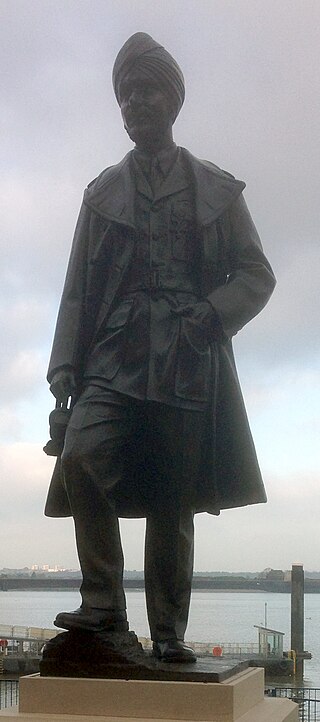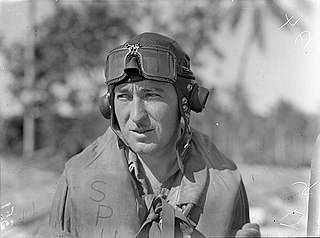No. 118 Squadron was a squadron of the British Royal Air Force. Originally formed in 1918, it served as a fighter squadron in the Second World War, flying Spitfires and Mustangs. It flew jet fighters as part of RAF Germany in the 1950s, and Bristol Sycamore helicopters in Northern Ireland before finally disbanding in 1962.

No. 486 (NZ) Squadron was a fighter squadron established for service during the Second World War. It was a New Zealand squadron formed under Article XV of the Empire Air Training Plan. Although many of its flying personnel were largely drawn from the Royal New Zealand Air Force, the squadron served in Europe under the operational and administrative command of the Royal Air Force.

Wing Commander Lance Cleo "Wildcat" Wade DSO, DFC & Two Bars was an American pilot who joined the Royal Air Force (RAF) during the Second World War and became a flying ace. He remained with RAF until his death in a flying accident in 1944 in Italy. He was described as a "distinguished American fighter ace who epitomized perhaps more than any other American airman the wartime accords between Britain and the United States".

Air Commodore Alan Christopher Deere, was a New Zealand fighter ace with the Royal Air Force (RAF) during the Second World War. He was also known for several near-death experiences over the course of the war. This led to his published autobiography being titled Nine Lives.

No. 609 Squadron of the Royal Auxiliary Air Force, originally formed as a bomber squadron and in the Second World War active as fighter squadron, nowadays provides personnel to augment and support the operations of the Royal Air Force. The squadron is no longer a flying squadron, but instead has the role of Force Protection. It is currently based at RAF Leeming, North Yorkshire.

Flight Lieutenant James Henry Whalen was a Canadian Second World War fighter pilot ace.

Group Captain Colin Falkland Gray, was a Royal Air Force (RAF) officer and the top New Zealand fighter ace of the Second World War.

Raymond Brown Hesselyn, was a New Zealand fighter pilot and flying ace of the Second World War, credited with the destruction of at least 18 enemy aircraft while flying with the Royal Air Force (RAF) over Europe and the Mediterranean.
Air Vice-Marshal Ekanayake Edward Rohan Ameresekere, was a senior officer in the Royal Ceylon Air Force. He served as the third Commander of the Royal Ceylon Air Force. He previously served he had served as a navigator in the Royal Air Force during World War II, before qualifying as a pilot in the newly formed Royal Ceylon Air Force.
Cyril Stanley "Bam" Bamberger, was a Royal Air Force pilot who fought in the Battle of Britain, the defence of Malta and the Korean War.

Squadron Leader Mohinder Singh Pujji DFC, also known as Mahinder Singh Pujji, was a distinguished Royal Air Force fighter pilot and one of the first Indian Sikh pilots to volunteer with the Royal Air Force during the Second World War. He is one of the few Indian pilots to have also served in all three major theatres of the Second World War.
No. 273 Squadron RAF was a Royal Air Force squadron formed as reconnaissance unit in World War I, and re-formed in World War II in Ceylon - initially as a torpedo bomber and reconnaissance unit. In mid 1944 the squadron was re-equipped with Spitfire Mk VIIIs and flew and fought out of airfields in India and Burma. Following the end of the war, the squadron was moved first to Siam (Thailand), and then later, French Indo-China (Vietnam). It was re-equipped with Spitfire Mk XIVs in November 1945.
Michel G. L. "Mike" Donnet, was a Belgian pilot who served in the Belgian Army and British Royal Air Force (RAF) during the Second World War. He shot down four enemy aircraft confirmed, and achieved the RAF rank of wing commander. After the war, he returned to the Belgian Air Force, and held several important commands before retiring in 1975.
Air Commodore Sir Archibald Little Winskill, was a British Royal Air Force officer. He flew Spitfires in the Battle of Britain and evaded capture twice during the Second World War on two different continents. After the war, he held a number of appointment in different parts of the world. After retiring from the RAF, he became Captain of the Queen's Flight.

No. 485 (NZ) Squadron was a fighter squadron established for service during the Second World War. It was the first New Zealand squadron formed under Article XV of the Empire Air Training Plan. Although many of its flying personnel were largely drawn from the Royal New Zealand Air Force, the squadron served in Europe under the operational and administrative command of the Royal Air Force.
Lawrence Seymour Goodman was a British airman and bomber pilot, who served in World War II. He was the last surviving wartime pilot of the No. 617 Squadron RAF which carried out Operation Chastise, although he did not join the squadron until after the operation.

Robert Lawrence "Peter" Spurdle was a New Zealand flying ace of the Royal Air Force (RAF) during the Second World War. He was credited with the destruction of ten enemy aircraft.

John Arthur Houlton was a New Zealand flying ace of the Royal New Zealand Air Force (RNZAF) during the Second World War. He was credited with the destruction of at least five German aircraft.
William Thomas Edward Rolls was a British flying ace of the Royal Air Force Volunteer Reserve (RAFVR) during the Second World War. He was credited with the destruction of at least 17 aircraft of the Axis powers.
John Jellicoe Blair, DFC (1919-2004) was a Jamaican Royal Air Force (RAF) pilot and navigator for RAF Bomber Command during the Second World War. Having been assigned to 102 (Ceylon) Squadron in December 1944, he navigated Halifax Bombers.










